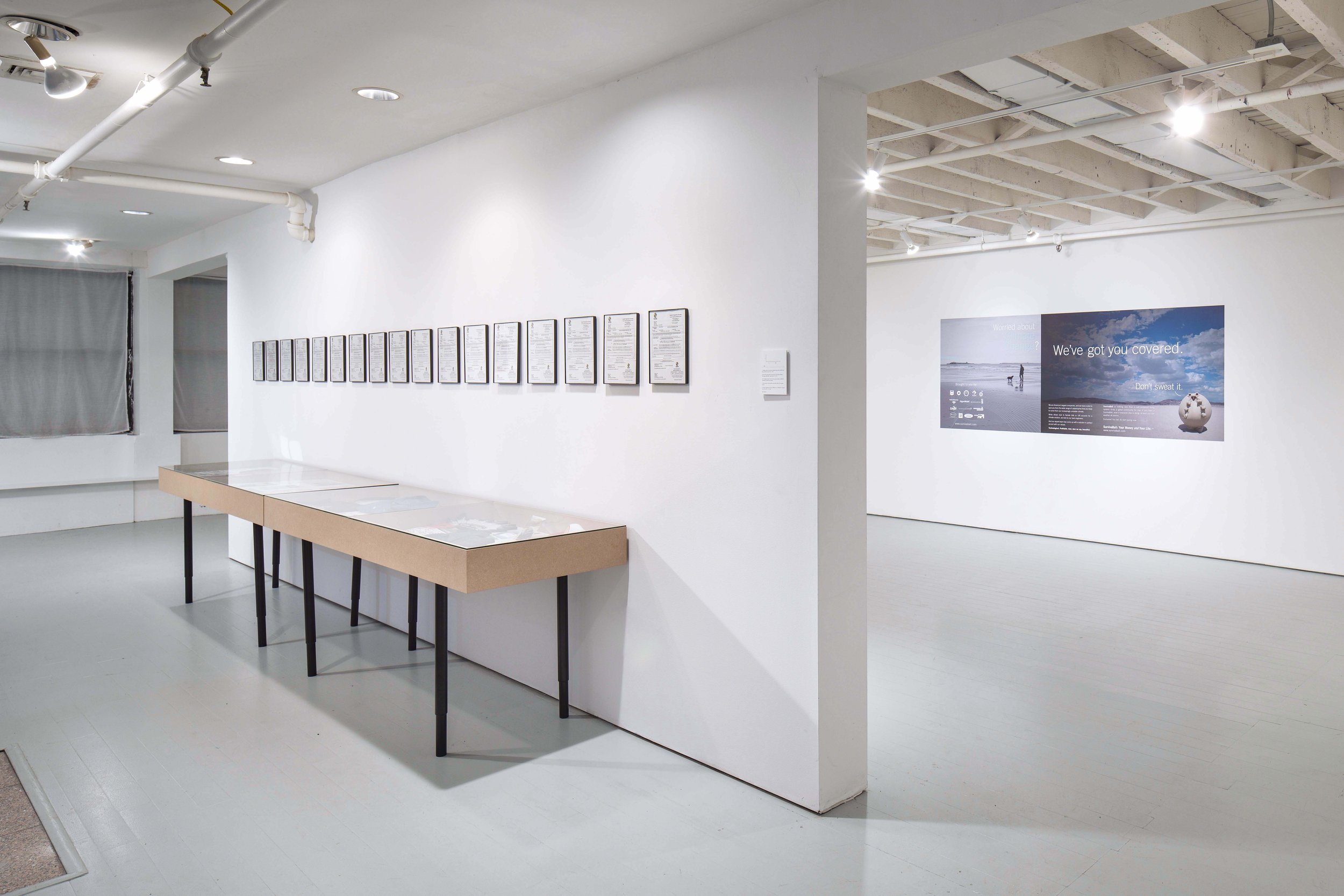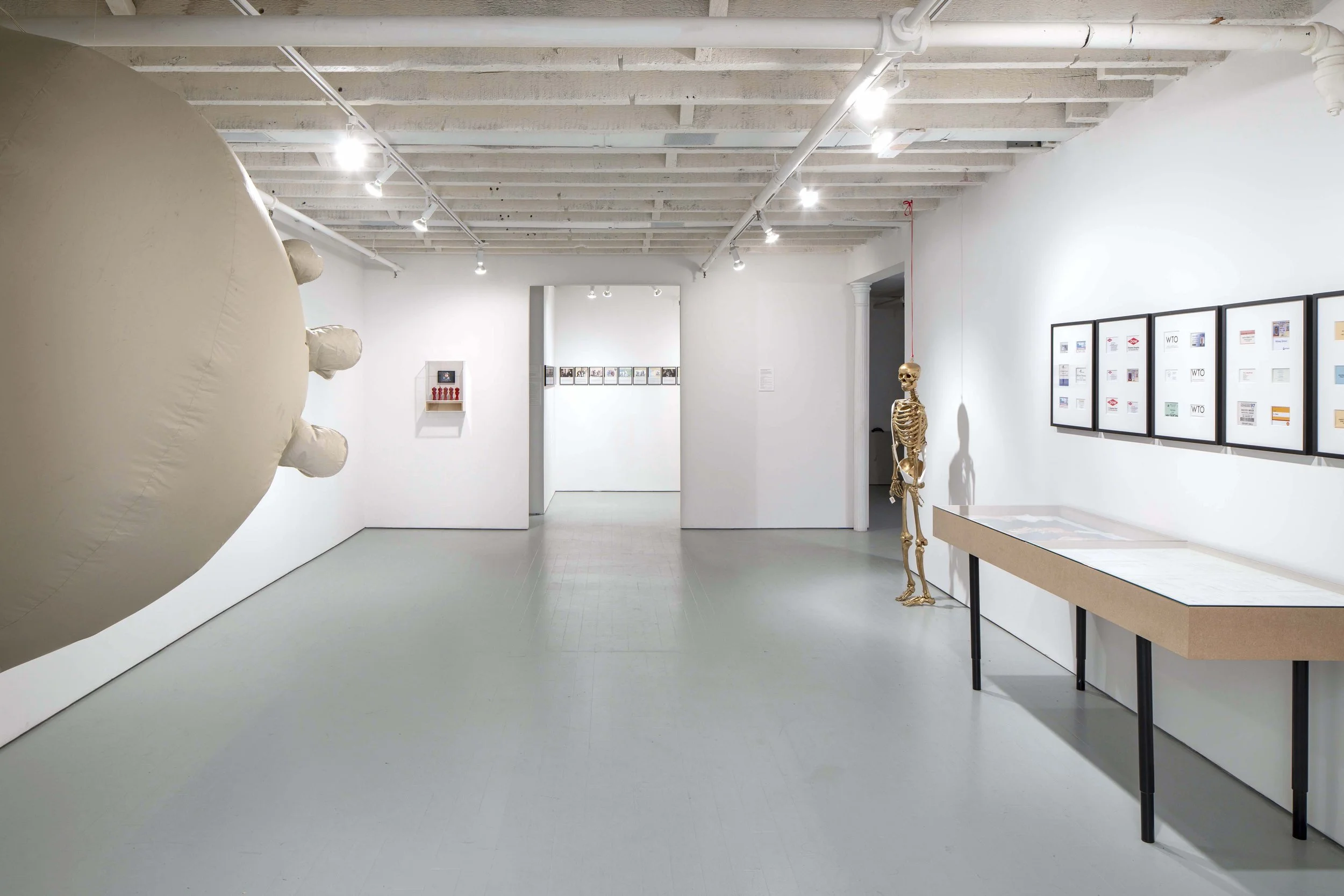The Yes Men
December 9, 2021 - April 10, 2022
The spectacle is the nightmare of imprisoned modern society which ultimately expresses nothing more than its desire to sleep. The spectacle is the guardian of sleep.
Guy Debord, The Society of the Spectacle, 1967
We tell you anything you want to hear. We lie like hell.
Howard Beale, Network, 1976
The world is asleep. The media’s waking dream encourages somnambulant nods of consent: It must be this way because the “dream” tells me so. Irrational justifications are assimilated into the long narrative, which proceeds regardless of rational dissent. While the dream proves a luxury for those watching at home, the lethal effects of nation-building, income inequality, and climate change are disastrous for the real actors subjected to them, continuing long after the cameras leave. As we’re reassured through careful information processing performed by familiar talking heads, the ceaseless pace of disaster spectacle precludes coherent analysis or effective response.
Emerging out of the gathering neoliberal fog of the early nineties, the Yes Men, a creation of Jacques Servin and Igor Vamos (or Andy Bichlbaum and Mike Bonanno) perform “identity-correcting” stunts in the heart of the corporate beast, exposing a latent brutality ordinarily veiled through a regular barrage of insidious PR campaigns. Confronting corporate-speak with a childlike earnestness (“what if they really did what they said?”) paired with brilliant subterfuge and cunning, the Yes Men’s “hijinks” provide periodic and necessary shocks to a system whose seamless messaging routinely serves as a means to disorient and immobilize the public.
Invited to appear on BBC news in 2004 via their (fake) Dow Chemical website, (fake) Dow spokesperson Jude Finisterra (Yes Men member Andy Bichlbaum) promised (falsely) on Dow’s behalf that they would take responsibility, twenty years later to the day, for the 1984 chemical explosion that killed and injured tens of thousands of people in and around Dow subsidiary Union Carbide’s Bhopal, India plant. Repeating a (real) Dow PR spokes-person’s assertion that paying $500 restitution per victim was “plenty good for an Indian”, Finisterra claimed Dow would now shed this “nightmare for the world” and spend billions to make things right. Since corporate bylaws lean towards shareholder profits over responsibility for “collateral damage” caused by their products, Dow’s stock predictably tumbled, losing $20 billion in value within twenty minutes of the announcement. When the hoax was revealed (Dow would not be doing the right thing) the stock’s value was promptly restored.
Posing as representatives from international corporations and governmental agencies (the WTO, Halliburton, the U.S. Chamber of Commerce, the U.S. Department of Housing and Urban Development, McDonald’s, etc.) the Yes Men breach the citadel of power through outwardly adhering to its codes and customs (business suits, official titles, etc.). Once inside, the fun begins: Publicly announce on behalf of the WTO that the organization will be dissolved due to its history of defending the interests of rich nations over poor ones. Hold a Chamber of Commerce press conference and announce that all the things the organization was once against, (climate change bills, minimum wage laws, etc.) it would now support. Or demo a new "Haliburton" product at "catastrophic loss" insurance conference that would spare top executives from harm when the world is finally deluged by climate change; a kind of "gated community for one" in the form of an inflatable sphere that attendees could try on for size.
Over the course of the last 25 years, through absurdist humor coupled with a knack for tweaking the social constraints of polite society, the Yes Men’s uncivil interruptions into the constant flow of corporate and political doublespeak are high-wire acts made in defense of civil society. Flipping the business-as-usual script and showing the world both as it is and as it could be, the Yes Men’s project, through three feature-length films and numerous interventions widely covered by mainstream media, embraces an idealism and political urgency that is neither sentimental nor self-righteous, while expressing an endless fascination with the revolutionary power of a great punch line. Carriage trade is very pleased to present this exhibition featuring their work.
Carriage trade would like to express its appreciation and thanks to the Yes Men, as well as to Lawrence B. Benenson, LMCC, New York State Council on the Arts (NYSCA), and Mr.Jacques Louis Vidal for their vital support. We’d also like to thank gallery assistants Laura Li, Kristal Uribe, Emilie Meyer, Ana Léon, Kristin Eichenberg, Xingyue Qiao, and Sosa Edokpayi for their invaluable efforts on this exhibition.
Photo credit: Still from The Yes Men Fix The World, 2009
Installation View (Entrance)
The Yes Men, carriage trade, photo: Nicholas Knight
Installation View
Dow Does the Right Thing, 2004, Hallway window, still from BBC World News appearance, clear vinyl, 51.5” x 97”, photo: Nicholas Knight
Installation View
The Yes Men, carriage trade, photo: Nicholas Knight
Installation View
GWBush.com, Domain registration invoices, 1999-2001, 15 framed documents, 8.5” x 11” each, photo: Nicholas Knight
Installation View
Left Vitrine (left side), The Yes Men, carriage trade, photo: Nicholas Knight
Installation View
Left Vitrine (right side), The Yes Men, carriage trade, photo: Nicholas Knight
Installation View
Right Vitrine (left side), The Yes Men, carriage trade, photo: Nicholas Knight
Installation View
The Yes Men, carriage trade, photo: Nicholas Knight
Installation View
Balls Across America, SurvivaBall (left), 2008, inflatable vinyl suit, fans, silicone, dimensions variable, SurvivaBall wall mural (right), 2021, matte vinyl, 45” x 125”, photo: Nicholas Knight
Installation View
Chevron Campaign Derailed (left), 2010, matte vinyl, 105” x 212”, Dow’s Golden Skeleton Is Unveiled, Gilda the golden skeleton (right), 2005, dimensions variable, photo: Nicholas Knight
Installation View
The Yes Men, carriage trade, photo: Nicholas Knight
Installation View
Chevron Campaign Derailed, 2010, matte vinyl, 105” x 212”, photo: Nicholas Knight
Installation View
The Yes Men, carriage trade, photo: Nicholas Knight
Installation View
Collection of fake business cards, 30 cards/IDs in five frames, 20” x 16” each (above), display cases (below), photo: Nicholas Knight
Installation View
“Integration and Conflict“ workshop poster, October 27, 2007, Florence, Italy, photo: Nicholas Knight
Installation View
Legal threat letters, 2002-2011, photo: Nicholas Knight
Installation View
The Yes Men, carriage trade, photo: Nicholas Knight
Installation View
Exxon’s Climate Victim Candles (a tribute to Reggie Watts), 2021, Plexiglass vitrine, framed photo, wax candles, MDF shelf, human hair, plexiglass, 19.5” x 14.5” x 6.5”, photo: Nicholas Knight
Installation View
The WTO’s Golden Phallus, 2001, “Globalization of Textile Trade” PowerPoint slides, 41 framed prints, 7” x 9” each, photo: Nicholas Knight
Installation View (Detail)
The WTO’s Golden Phallus, 2001, “Globalization of Textile Trade” PowerPoint slides, 41 framed prints, 7” x 9” each, photo: Nicholas Knight
Installation View
The WTO’s Golden Phallus (left), 2001, “Globalization of Textile Trade” PowerPoint slides, 41 framed prints, 7” x 9” each, The WTO’s Golden Phallus (right), 2001, video excerpt from “The Employee Visualization Appendage", 3 min 19 sec., photo: Nicholas Knight
Installation View
The Yes Men, carriage trade, photo: Nicholas Knight
Installation View
Still from The Yes Men Fix the World (2009), photo: Nicholas Knight
Installation View
Dow Does the Right Thing (left), 2004, excerpt from The Yes Men Fix the World (2009), 5 min 29 sec. (looped), Dow Does the Right Thing (right), 2004, Hallway window, still from BBC World News appearance, clear vinyl, 51.5” x 97”, photo: Nicholas Knight
Installation View
The Yes Men, carriage trade, photo: Nicholas Knight
Installation View
New York Times Special Edition, New York Times wall mural (above), front page, 2008-2021, matte vinyl, 71” x 37.5”, Newspaper stacks (below), 2008-2021, newspapers, dimensions variable, photo: Nicholas Knight



























